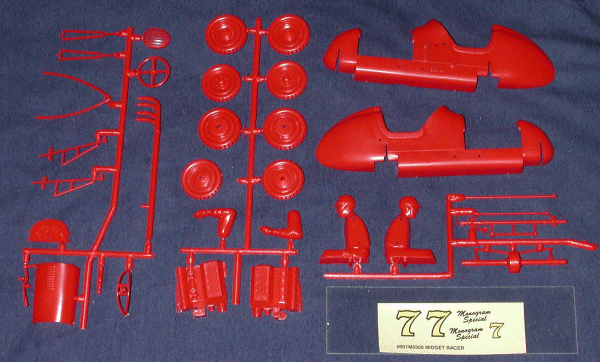
|
KIT: |
Monogram Midget Racer |
|
KIT # |
P 1 |
|
PRICE: |
$10.00 |
|
DECALS: |
One car |
|
REVIEW & |
|
|
NOTES: |
1995 reissue |

|
HISTORY |
Back when I was really into cars, I used to go to the local bull ring dirt track to watch the car races. Every few months, they would bring in the midget racers. These small open-wheeled cars looked very much like what was the norm for Indianapolis until the mid-1960s when rear-engined cars were introduced. The midgets were front engined, rear drive, and powered by either a four-cylinder Offenhauser or small Ford flathead V8. They had relatively skinny tires that were often grooved to allow for traction on the high-banked dirt track that they ran on. These small cars were perfect for the 1/5 mile track and zipped around, slinging mud into the stands for the duration of the race. Like other similar cars, there was no starter and the cars had to be push started. The only protection offered were the rear push bar and a front bar that was more for protection of the radiator than anything else. Drivers wore little more than a cursory crash helmet and perhaps a set of overalls with their names on them.
Nowadays, the midget is very much a high tech car. Fat tires, roll cages, fire suits, VW or other small 4 cylinder engines tuned to within an inch of their lives, and festooned with sponsor decals, these cars have little in common with the older midget other than front engine and overall displacement. Unlike older midgets, today's drivers rarely get badly injured and are generally paid a lot better!
|
THE KIT |

This was Monogram's first injected plastic kit. The copyright on the kit instructions is 1954, a time when most modelers were building with wood. This new-fangled styrene plastic was something that most 'real modelers' decried as being something for kids. Where was the skill in just gluing a few parts together. It was a fad that would soon die out and return things to the proper order. Sound familiar? It didn't happen and styrene plastic took over the hobby.
I'm not really sure of the scale, but I'd hazard a guess as to about 1/20th or so. (Turns out this is pretty close. Tom Avenengo wrote me that he has scaled it out to 1/18th. Ed) It really is much larger a kit than one would think. All of the parts are molded in red plastic and it has engraved panel lines! No rubber or clear bits, though a section of clear acetate is provided for you to make the windscreen. It does have a full engine, though detail is a bit basic. No radiator, no drive shaft, just two engine halves and an exhaust pipe. The interior is also a bit lacking. While there is a dash and steering wheel, there is no seat. You are provided with a rather large driver to place instead.
There are also a set of decals for 'Monogram Racing' #7. Construction of the kit looks to be simple and one that can easily be done by any modeler. After all, it is an entry level model and most who built this kit back in the early 1950s were doing so for the first time!
A bit of nostalgia for many of us and a kit that any modeler should be able to enjoy.
Review kit courtesy of me and my wallet!
If you would like your product reviewed fairly and quickly by a site that averages thousands of visits a day, please contact me or see other details in the Note to Contributors.